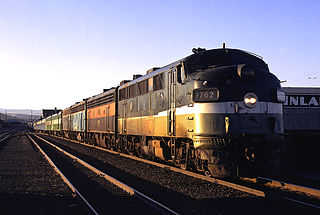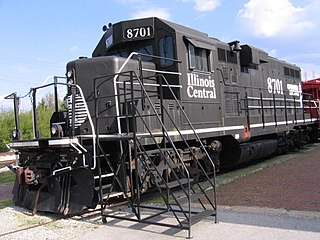This article needs additional citations for verification .(July 2020) |

The EMD FP10 was a series of rebuilt F-unit locomotives originally operated on the MBTA Commuter Rail system.
This article needs additional citations for verification .(July 2020) |

The EMD FP10 was a series of rebuilt F-unit locomotives originally operated on the MBTA Commuter Rail system.
The FP10 units were rebuilt in the late 1970s by the Illinois Central Gulf Railroad at its Paducah, Kentucky shops for the Massachusetts Bay Transportation Authority using former Gulf, Mobile and Ohio Railroad F3 and F7 units. These F3 and F7 locomotives were used by the GM&O and ICG (for a short period) in Chicago-area commuter service and later in freight service until their retirement. Despite their designation, the FP10s locomotives were not the linear successors of the FP9.
The rebuilding by ICG saw all of the units gain full-length stainless steel air intake grilles, which in many cases replaced the 'chicken wire' appearance which many had during their tenure with the GM&O and ICG. They were also equipped with a 480 V HEP generator at the rear of the locomotive, as well as dynamic brakes, and had their classification lights replaced with large red marker lights which enabled the locomotive to "carry the markers" when operating in push mode.
Unlike the FP7 and FP9, the FP10 units were never extended beyond their original length, thus making the "P" in their designation misleading. The FP10 designation, like that of the GP10 (also an ICG product) was conceived by ICG and was never sanctioned by EMD, though railroads and rail enthusiasts alike agree on the moniker.
The FP10 locomotives were painted in the MBTA's purple, silver, and yellow scheme, wearing two variations (one which had two substantial yellow swaths on the nose, and the second which used the yellow only as striping on the nose, as well as the rest of the carbody) of the transit agency's dress. At least one was painted in a scheme that was a "negative" of the conventional scheme, where purple was the primary color and silver taking a secondary role. [1]
During the early 1990s, the FP10s were retired by the MBTA, with four being sold to the Metro-North Commuter Railroad (MNCR 410-413), some leased (Cape Cod Central—and eventually resold after that operation ceased) and others being scrapped. In late 1999/early 2000, the last remaining MBTA-owned FP10 units were sold and have operated in Maryland, New Orleans, Georgia, and Idaho on various tourist trains.
Chessie System, Inc. was a holding company that owned the Chesapeake and Ohio Railway (C&O), the Baltimore and Ohio Railroad (B&O), the Western Maryland Railway (WM), and Baltimore and Ohio Chicago Terminal Railroad (B&OCT). Trains operated under the Chessie name from 1973 to 1987.

The EMD F40PH is a four-axle 3,000–3,200 hp (2.2–2.4 MW) B-B diesel-electric locomotive built by General Motors Electro-Motive Division in several variants from 1975 to 1992. Intended for use on Amtrak's short-haul passenger routes, it became the backbone of Amtrak's diesel fleet after the failure of the EMD SDP40F. The F40PH also found widespread use on commuter railroads in the United States and with VIA Rail in Canada. Additional F40PH variants were manufactured by Morrison-Knudsen and MotivePower between 1988 and 1998, mostly rebuilt from older locomotives.

EMD F-units are a line of diesel-electric locomotives produced between November 1939 and November 1960 by General Motors Electro-Motive Division and General Motors-Diesel Division. Final assembly for all F-units was at the GM-EMD plant at La Grange, Illinois, and the GMDD plant in London, Ontario. They were sold to railroads throughout the United States, Canada and Mexico, and a few were exported to Saudi Arabia. The term F-unit refers to the model numbers given to each successive type, all of which began with the letter F. The F originally meant "fourteen", as in 1,400 horsepower (1,000 kW), not "freight". Longer EMD E-units for passenger service had twin 900-horsepower (670 kW) diesel engines. The E meant "eighteen" as in 1,800 horsepower (1,300 kW). Similarly, for early model EMD switchers, S meant "six hundred" and N meant "nine hundred horsepower".

The EMD F3 is a 1,500-horsepower (1,100 kW) B-B freight- and passenger-hauling carbody diesel locomotive produced between July 1945 and February 1949 by General Motors’ Electro-Motive Division. Final assembly was at GM-EMD's La Grange, Illinois plant. A total of 1,111 cab-equipped lead A units and 696 cabless booster B units were built.

In North American railroad terminology, a cab unit is a railroad locomotive with its own cab and controls.

The EMD F7 is a model of 1,500-horsepower (1,100 kW) diesel-electric locomotive produced between February 1949 and December 1953 by the Electro-Motive Division of General Motors (EMD) and General Motors Diesel (GMD).

The EMD F9 is a 1,750 horsepower (1,300 kW) Diesel-electric locomotive produced between February 1953 and May 1960 by the Electro-Motive Division of General Motors (EMD) and General Motors Diesel (GMD). It succeeded the F7 model in GM-EMD's F-unit sequence. Final assembly was at GM-EMD's La Grange, Illinois plant. The F9 was also built in Canada by General Motors Diesel at their London, Ontario plant. A total of 101 cab-equipped lead A units and 156 cabless booster B units were built. The F9 was the fifth model in GM-EMD's highly successful "F" series of cab unit diesel locomotives.

The EMD FL9 is a model of electro-diesel locomotive, capable of operating either as a traditional diesel-electric locomotive or as an electric locomotive powered from a third rail. Sixty units were built between October 1956 and November 1960 by General Motors Electro-Motive Division for the New York, New Haven and Hartford Railroad.

The Gulf, Mobile and Ohio was a Class I railroad in the central United States whose primary routes extended from Mobile, Alabama, and New Orleans, Louisiana, to St. Louis and Kansas City, Missouri, as well as Chicago, Illinois.

The EMD GP9 is a four-axle diesel-electric locomotive built by General Motors' Electro-Motive Division between 1954 and 1959. The GP9 succeeded the GP7 as the second model of EMD's General Purpose (GP) line, incorporating a new sixteen-cylinder engine which generated 1,750 horsepower (1.30 MW). This locomotive type was offered both with and without control cabs; locomotives built without control cabs were called GP9B locomotives.

The EMD SD40 is an American 6-axle diesel-electric locomotive built by General Motors Electro-Motive Division between January 1966 and August 1972. 1,268 locomotives were built between 1966 and 1972. In 1972, an improved version with new electronics was developed and marketed as a new locomotive, the SD40-2.

The EMD SD45-2 is a 6-axle diesel-electric locomotive built by General Motors Electro-Motive Division (EMD). EMD built 136 locomotives between 1972 and 1974, primarily for the Atchison, Topeka and Santa Fe Railway (ATSF). The SD45-2 was an improved version of the EMD SD45; the primary visual difference is the absence of flared radiators on the SD45-2.

The EMD SD40A is a model of diesel-electric locomotive built by General Motors Electro-Motive Division between 1969 and 1970. 18 locomotives were built for the Illinois Central Railroad.

The "Beep" is an individual switcher locomotive built in 1970 by the Atchison, Topeka and Santa Fe Railway at its Cleburne, Texas, workshops. Technically a rebuild, the Beep originally entered service on the Santa Fe as a Baldwin Model VO-1000. Following its successful CF7 capital rebuilding program, the company hoped to determine if remanufacturing its aging, non-EMD end cab switchers by fitting them with new EMD prime movers was an economically viable proposition. The conversion procedure proved too costly and only the one unit was modified. In 2008-2009, this locomotive was retired and stored operational at Topeka, Kansas. In May 2009 the unit was donated to the Western America Railroad Museum in Barstow, California.

The passenger locomotives derivatives of the General Motors EMD GP40 diesel-electric locomotive have been, and continue to be, used by multiple passenger railroads in North America. For passenger service, the locomotives required extra components for providing steam or head-end power (HEP) for heating, lighting and electricity in passenger cars. Most of these passenger locomotives were rebuilt from older freight locomotives, while some were built as brand new models.

The GE P30CH was one of the first brand-new diesel-electric locomotives built for Amtrak by General Electric during Amtrak's early years. The design was based on the GE U30C, but had a cowl carbody like its EMD competitors. Amtrak operated them between 1975 and 1992.

The Via Rail FP9ARM was a re-manufactured version of a GMD FP9A Diesel passenger locomotive, rebuilt between 1983 and 1985 by Canadian National Railways at their Pointe St-Charles shops.

The EMD GP11 is a four-axle diesel locomotive rebuilt by the Illinois Central Railroad's Paducah shops. It is very similar in appearance to the GP8 and GP10.

The ALCO RS-3m is a diesel-electric locomotive rebuilt from an ALCO RS-3 road switcher. These 98 locomotives were rebuilt to replace their original ALCO prime mover with the more reliable EMD 567B engine and fan assemblies taken from retired E8s. Many of these rebuilds were performed by the ex NYC DeWitt shop with 56 completed at the ex PRR Juniata shop. The RS3m rebuild program started in 1972 and continued until 1978 under Conrail.
Maine Central Railroad began operating diesel locomotives in 1935, and had retired all steam locomotives by 1954. That time interval was a joint operating period with the Boston and Maine Railroad (B&M). This article describes diesel locomotives owned by Maine Central through the period of joint operation and later independent operation prior to Guilford Rail System control in 1981.